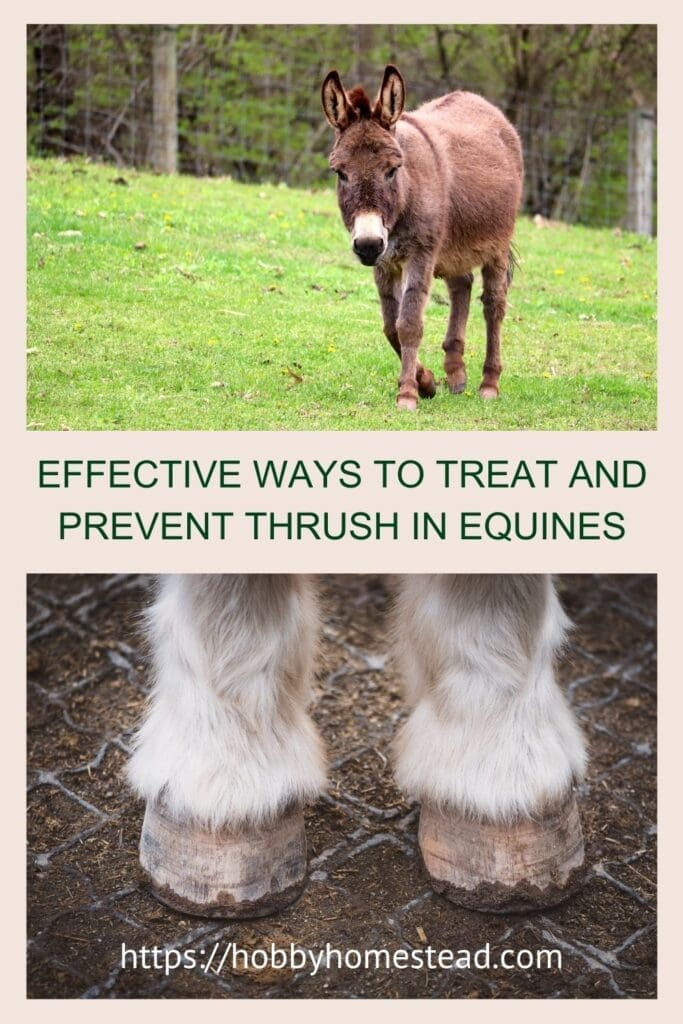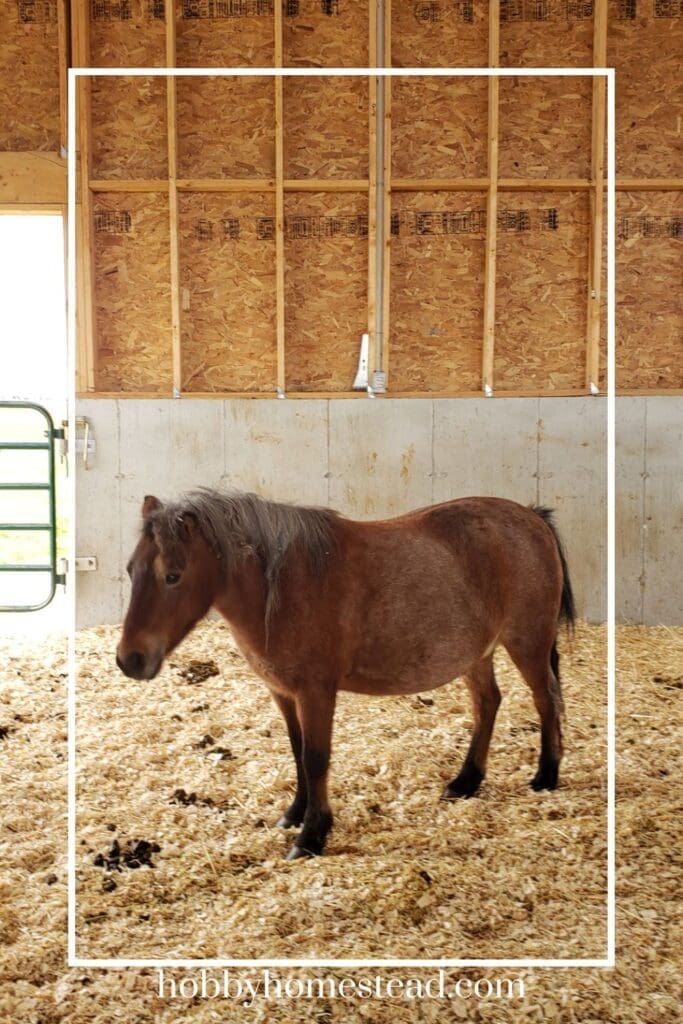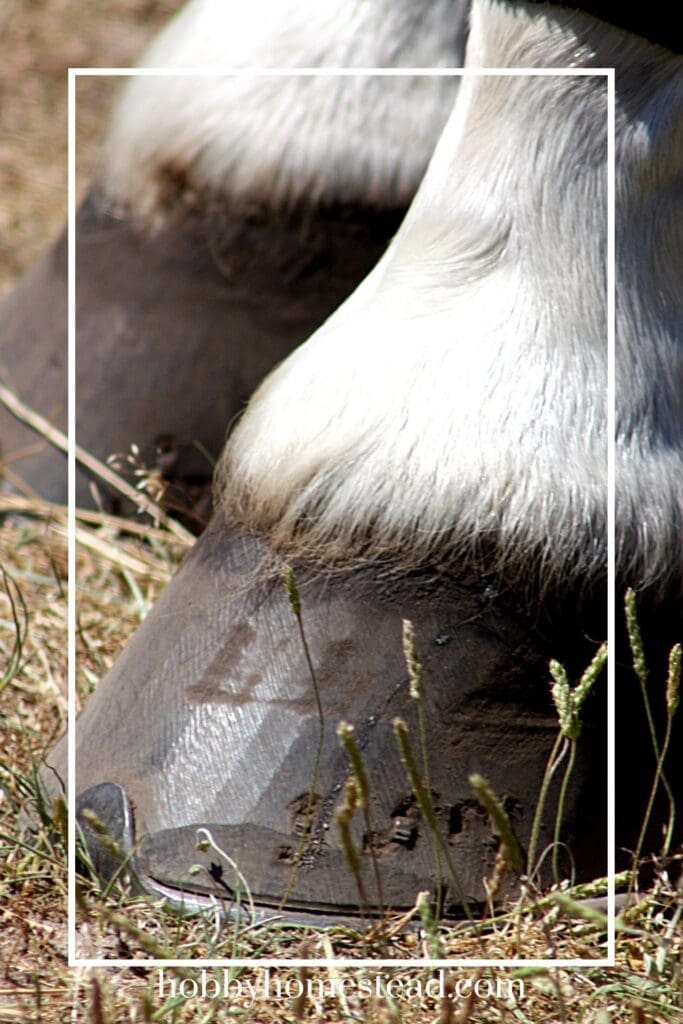Last updated on January 9th, 2025 at 07:51 am
Let’s talk about how to Treat and Prevent Thrush in Equines. Dealing with thrush in our miniature donkey and miniature horse has been a learning experience for us as equine owners.
We first noticed the telltale signs. A foul odor and black discharge around their hooves. We quickly realized we needed to act before the infection worsened.
Thrush in Minis
Thrush, a common condition in equines, can be tricky to manage, especially in smaller breeds like minis, where sensitive tissue can become easily irritated. Through consistent cleaning, topical treatments, and creating a dry environment, we’ve been able to get them back on track.
Along the way, we’ve gained valuable insight into recognizing, treating, and preventing thrush, which we’re excited to share with you in this guide.

A Common Condition in Equines
Thrush is a common condition in equines that affects the horse’s hooves, particularly the sensitive tissue in the frog area. It’s caused by anaerobic bacteria, most notably Fusobacterium necrophorum, which thrives in wet conditions and unhygienic environments.
For horse owners, understanding how to recognize, treat, and prevent equine thrush is crucial for maintaining hoof health and avoiding complications like permanent lameness.
What is Thrush?
Thrush is a bacterial infection that targets the frog tissue of a horse’s hoof, especially in areas like the central sulcus of the frog and collateral sulci. The infection typically produces a foul odor and may result in black discharge around the horse’s foot. If left untreated, it can invade deeper structures such as the digital cushion and hoof wall, leading to severe pain and hoof conditions.
Common Causes and Risk Factors
The development of thrush is often linked to the following.
- Long periods in a stall without proper cleaning
- Lack of Exercise, which reduces blood flow to the hooves. While thrush is commonly associated with unkempt living spaces, even the most pampered ponies can become infected if they aren’t exercised often. Likewise, your horse can get a workout every day and still get thrush if they go home to muddy stalls.
- Wet conditions (e.g., muddy pastures, unclean stalls)
- Poor hoof conformation or foot conformation
- Unhygienic conditions, providing a breeding ground for thrush-causing bacteria
Clinical Signs of Thrush
Recognizing the horse thrush symptoms early can lead to prompt treatment. Common signs include:
- A foul odor coming from the horse’s hooves
- Black discharge in the affected area
- Softening or deterioration of the frog tissue, particularly in the middle of the frog
- Pain or sensitivity in the horse’s feet
- Lameness in severe cases of thrush
Effective Treatment of Thrush
Addressing hoof thrush requires a combination of topical treatments, improved hygiene, and appropriate treatment of the underlying issues. Here are the steps for effective treatment.
Clean the Affected Area
Use a hoof pick to remove dirt, manure, and debris from the sides of the frog and the deep sulci. Clean thoroughly to expose the affected tissue for treatment.
Apply Topical Medication
Apply antibacterial solutions or commercial products specifically designed for thrush. Some thrush products include iodine-based treatments, hydrogen peroxide, or topical medication with antifungal properties. Always follow the product’s instructions.
Trim and Maintain Hooves
Regular trimming by a farrier ensures good hoof conformation, reducing the risk of thrush and other hoof conditions. Removing overgrown areas prevents bacterial growth and improves access to the affected area during treatment.

Provide a Dry Environment
A dry environment is essential for the prevention of thrush. One of the first steps should be to remove all wet or soiled flooring from the horse’s living area. The bacteria came from these moist materials, so they need to be removed before there’s any chance of curing the infection. Replace it with clean, dry flooring. Ensure the horse has access to clean, dry bedding and minimize time spent in muddy conditions.
Monitor Progress
For mild cases of thrush, daily cleaning and treatment often resolve the issue within a week or two. In severe cases of thrush, consult a veterinarian for advice on additional therapies to protect the deeper structures and healthy tissue.

Prevention of Thrush in Horses
The best way to avoid horse’s thrush is through proper care and good hoof hygiene. Consider these preventative measures:
Regular Trimming of Hooves. Prevents buildup of debris and maintains hoof tissue health.
Daily Hoof Cleaning. Use a hoof pick to keep the sides of the frog and hoof wall free of dirt and manure.
Exercise. Promotes blood flow and keeps the hoof strong.
Control Environmental Conditions. Ensure stalls are clean and dry and provide regular turnout.
Inspect Hooves Regularly. Early detection of thrush infection can prevent serious damage.
Top Thrush Products for Horse Owners
A variety of thrush products are available to help treat and prevent infections. Some popular options include:
Antibacterial solutions like Thrush Buster
Natural Remedies
Natural remedies like tea tree oil-based ointments can be a gentle yet effective option for treating thrush in horses and donkeys. Tea tree oil is known for its antibacterial and antifungal properties, making it a natural alternative to chemical treatments. These ointments work by targeting the anaerobic bacteria and fungi that thrive in the deep sulci and central sulcus of the frog, helping to combat the infection while promoting the healing of healthy tissue.
Benefits of Tea Tree Oil Ointments
- Soothing and Healing. Tea tree oil helps calm inflammation and supports the regeneration of hoof tissue in the affected area.
- Non-Caustic. Unlike harsher chemical treatments, tea tree oil-based remedies are less likely to irritate sensitive tissue in the hoof.
- Easy Application. These ointments can be applied directly to the middle of the frog, collateral sulci, or any areas showing clinical signs of thrush, such as black discharge or a foul odor.
How to Use Tea Tree Oil-Based Ointments
- Start by thoroughly cleaning the horse’s hoof using a hoof pick to remove dirt and debris, focusing on the sides of the frog and heel bulbs.
- Dry the hoof completely to create an environment where bacteria and fungi are less likely to thrive.
- Apply a small amount of tea tree oil-based ointment to the affected tissue, ensuring it penetrates any deep sulci or crevices where the infection is present.
- Repeat the application daily until the thrush infection clears up, and continue for a few days afterward to ensure all bacteria and fungi are eradicated.
While tea tree oil-based remedies are a great natural option, they are most effective in mild cases of thrush or as a preventative measure. For severe cases, they may need to be used alongside more intensive treatments or under the guidance of a veterinarian or farrier. Additionally, combining these ointments with good hoof hygiene and a dry environment is essential for preventing future infections.
Commercial Products
Commercial products designed for hoof thrush, which often combine antibacterial and antifungal properties.
Hoof Soak Treatment
One method of treatment is to soak the hoof. Fill a bucket or hoof boot with water, and a treatment powder such as Hoof Soak. Mix in the treatment powder and submerge the hoof for 40 to 60 minutes. Another option is to use a solution of 80/20 water and hydrogen peroxide as a hoof soak.
During the soak, you may notice the water changing color as infected material is drawn out from the hoof. For persistent infections, this process can be repeated after 2-4 weeks.
For milder cases, a spray treatment like Vetericyn Hoof Care may be sufficient. This daily-use formula is easy to apply and includes a blue dye. Which lets you see at a glance if the product is still active and protecting the hoof.
In extremely severe cases, where the infection has eaten away at the hoof and exposed raw, sensitive tissue deep in the foot, chemical soaks might not be appropriate. In such situations, a veterinarian can prepare an antibacterial paste using tablets and apply it directly to the affected area before securely bandaging the hoof to promote healing.
Koppertox Treatment
We had Koppertox on hand, so we are treating our equines with that. Antibacterial and antifungal. It effectively combats the anaerobic bacteria (Fusobacterium necrophorum) and fungal infections that contribute to thrush.
It is waterproof and it adheres well to the hoof, even in wet conditions, ensuring lasting protection.
Things to Consider
- Strong smell and staining. Like many thrush treatments, it has a strong odor and can stain hooves, hands, and clothing green.
- Avoid overuse. While effective, overusing Koppertox can irritate healthy tissue or make the frog excessively hard, potentially leading to cracking.
- Use in moderation. Apply only to the affected area, such as the central sulcus of the frog and deep sulci, to target the infection without harming surrounding tissues.
For mild to moderate cases of thrush, Koppertox is a reliable option. For severe cases of thrush or persistent infections, you may need to combine it with improved hoof hygiene, environmental changes, and advice from your veterinarian or farrier.

When to Call a Veterinarian
If you notice signs of infection spreading to the deeper structures, such as persistent lameness or increased sensitivity in the heel bulbs, seek professional help immediately. These symptoms may indicate the severity of the infection requires advanced care.
Preventing Tetanus in Horses
Tetanus is a serious bacterial infection caused by Clostridium tetani, which can enter the horse’s body through wounds, including those on the soles of their feet. Once inside, the bacteria release neurotoxins that attack the nervous system, potentially leading to fatal consequences. Because severe thrush infections can create open wounds on the soles of the hoof, they can increase the risk of a tetanus infection.
Thankfully, tetanus is highly preventable with proper care. Keeping your horse up to date on tetanus vaccinations is the most effective defense. For horses that are unvaccinated or have an unknown vaccination history, immediate action is crucial. If such a horse develops a severe thrush infection, administering a tetanus antitoxin promptly can help protect them from this life-threatening condition.
Regular vaccinations and diligent hoof care can significantly reduce the risk of tetanus and support your horse’s overall health and safety.
Conclusion
Thrush is a preventable and treatable condition when addressed with common sense and regular care. Horse owners can keep their horse’s feet healthy by maintaining a clean environment, practicing good hoof hygiene, and applying effective treatment promptly. With proper management, your equines can stay free from hoof conditions and enjoy long-term wellness.
References
Merck Vet Manual. Thrush in Horses.
The British Horse Society. Thrush.
Vetericyn. Horse Thrush Symptoms, Treatment, and More.


